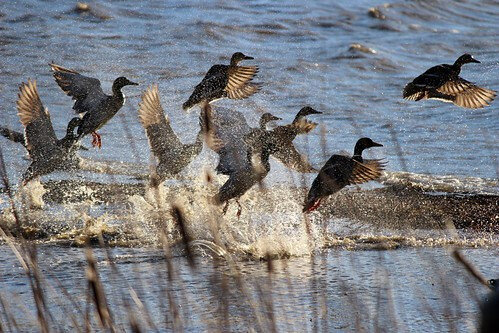Midwinter 2024 Waterfowl Survey results down but about par with five-year average
ANNAPOLIS — In early January, aerial survey teams of pilots and biologists from the Maryland Department of Natural Resources and U.S. Fish and Wildlife Service conducted their annual population …

You must be a member to read this story.
Join our family of readers for as little as $5 per month and support local, unbiased journalism.
Already a member? Log in to continue. Otherwise, follow the link below to join.
Please log in to continue |
Midwinter 2024 Waterfowl Survey results down but about par with five-year average
ANNAPOLIS — In early January, aerial survey teams of pilots and biologists from the Maryland Department of Natural Resources and U.S. Fish and Wildlife Service conducted their annual population estimates of ducks, geese and swans along the state’s Chesapeake Bay, tidal Potomac River and Atlantic coast shorelines.
This year, the teams counted about 593,200 waterfowl which was lower than the 632,200 birds observed in 2023 but consistent with the most recent five-year average of 596,500 birds.
“Waterfowl are continually responding to environmental cues like weather and food availability as they seek resources necessary to ensure their survival,” said Wildlife and Heritage Director Karina Stonesifer. “The standardized survey protocols associated with the Mid-Winter Survey allow our biologists to assemble a long-term picture of waterfowl abundance and distribution in Maryland, and this survey represents one of the department’s many contributions to state, regional, and continental waterfowl data collection efforts used to manage this valuable resource.”
Overall, dabbling duck numbers (91,300) were similar to the 2023 count of 93,600 birds. While the number of mallards (45,100) and black ducks (24,200) were close to their respective 5-year averages (50,800, and 21,760), the number of green-winged teal counted in 2024 (17,500) was much higher than recent years.
The 2024 mid-winter survey was conducted during the first two weeks of January, just prior to the cold weather that occurred later in the month. The timing of the survey flights likely led to lower diving duck counts than in 2023 (190,300). Biologists counted 350,500 Canada geese in the 2024 survey effort which was slightly higher than both the 320,800 geese counted in 2023 and the 5-year average (321,960).
The Midwinter Waterfowl Survey has been conducted annually since the early 1960s and covers most of the tidal shorelines and near-shore waterfowl habitat in Maryland (see below for survey results from the last 5 years).
Midwinter Waterfowl Survey Results 2019-2024*
Figures rounded to the nearest hundred
|
Species |
2019 |
2020 |
2022 |
2023 |
2024 |
|
Mallard |
39,000 |
56,000 |
53,500 |
56,800 |
45,100 |
|
Black Duck |
17,200 |
21,000 |
24,600 |
21,800 |
24,200 |
|
Gadwall |
4,800 |
10,800 |
6,800 |
3,400 |
2,600 |
|
Widgeon |
1,200 |
1,100 |
300 |
1,900 |
500 |
|
Green-winged teal |
1,500 |
2,000 |
6,900 |
6,200 |
17,500 |
|
Shoveler |
100 |
300 |
900 |
200 |
100 |
|
Pintail |
600 |
1,800 |
4,600 |
3,300 |
1,300 |
|
Total Dabblers |
64,400 |
93,000 |
97,600 |
93,600 |
91,300 |
|
Redhead |
20,600 |
10,600 |
7,000 |
12,800 |
10,000 |
|
Canvasback |
46,000 |
46,900 |
7,700 |
57,800 |
18,800 |
|
Scaup |
72,100 |
59,000 |
29,500 |
74,000 |
28,400 |
|
Ring-necked duck |
1,100 |
3,000 |
2,100 |
6,200 |
7,000 |
|
Goldeneye |
100 |
300 |
100 |
400 |
300 |
|
Bufflehead |
13,200 |
11,400 |
10,600 |
16,800 |
16,300 |
|
Ruddy duck |
28,900 |
18,500 |
22,400 |
22,300 |
39,500 |
|
Total Divers |
182,000 |
149,700 |
79,400 |
190,300 |
120,300 |
|
Scoters |
27,800 |
5,700 |
1,300 |
3,400 |
1,800 |
|
Long-tailed Duck |
300 |
200 |
100 |
100 |
100 |
|
Mergansers |
2,000 |
2,300 |
1,400 |
1,700 |
1,900 |
|
Total Ducks |
276,500 |
250,900 |
179,800 |
289,100 |
215,400 |
|
Brant |
900 |
900 |
200 |
400 |
1,100 |
|
Snow Goose |
34,700 |
40,900 |
13,600 |
12,500 |
16,100 |
|
Canada Goose |
250,200 |
327,200 |
361,100 |
320,800 |
350,500 |
|
Tundra Swan |
4,000 |
7,100 |
7,400 |
7,300 |
9,600 |
|
Total Waterfowl |
566,300 |
627,000 |
563,800 |
632,200 |
593,200 |
*The survey was not conducted in 2021 due to the Covid pandemic.






